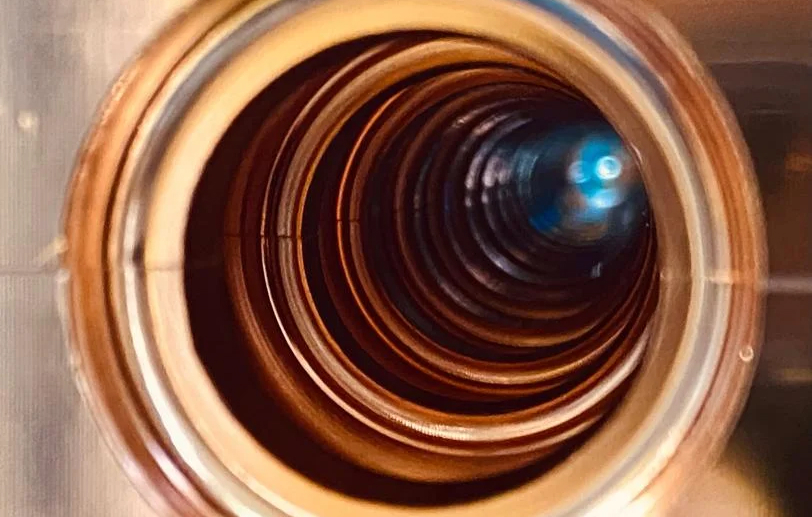Exploring the Potential for Increased Energy Efficiency in Particle Colliders

November 3, 2023
This article has undergone a review in compliance with Science X's editorial process and policies. The editors noted the following features, confirming the content's reliability:
- fact-checked
- trusted source
- proofread
by Nathan Collins, SLAC National Accelerator Laboratory
Since the identification of the Higgs boson in 2012, there has been a growing interest among physicists to construct new particle colliders to explore the peculiarities of this elusive particle and delve deeper into elementary particle physics at continually increasing energy scales.
However, such endeavor requires a considerable amount of energy. A standard collider needs hundreds of megawatts equivalent to tens of millions of modern lightbulbs to function. Building these devices also requires a substantial amount of energy, contributing to an increase in carbon dioxide and other greenhouse gases emissions.
Now, scientists from the Department of Energy's SLAC National Accelerator Laboratory and Stanford University are investigating how to make the Cool Copper Collider (C3) proposal more energy-efficient.
Three primary considerations were taken into account for any accelerator design: its operation, its construction, and its location. The latter factor has a significant indirect effect on the total carbon footprint of the project.
Caterina Vernieri, an assistant professor at SLAC and a co-author of the new article published in PRX Energy, proclaimed that environmental impacts must be critically thought about in addition to financial costs when examining expansive science projects.
Another co-author, Emilio Nanni, an assistant professor at SLAC, expressed the same sentiments. He argues that as researchers, they aim to inspire others through discoveries and actions while considering the scientific impact and the broader community impact. Ultimately, making facilities more sustainable contributes to achieving both aims.
C3 is just one out of an array of potential next-generation accelerators. Although each design follows one of two basic designs either linear accelerators, like C3, or synchrotrons, like the Future Circular Collider, each comes with their set of pros and cons.
Significantly, synchrotrons can recirculate particle beams, allowing data collection over multiple loops, but there are limitations due to energy loss when bending charged particles into a circle, leading to increased power need. On the other hand, linear accelerators do not have this energy loss issue, enabling them to attain higher energy levels and potentially new measurements, although they only utilize the beam once.
C3 offers a potential solution to the length-energy restrictions of most linear accelerators. This solution includes a new design that incorporates more accurately customized electromagnetic fields, a new cryogenic cooling system, and a smaller, more cost-efficient design that can probe the ultimate boundaries of particle physics.
The proposed C3 collider, despite its many advantages, would still require significant resources to build and operate. Therefore, the scientists carefully considered the project's carbon footprint, starting with the operation of the accelerator itself.
In the past, physicists didn't prioritize energy efficiency in operating accelerators. The team from SLAC and Stanford discovered that minute adjustments, such as modifying the particle beam structure and enhancing the operation of klystrons, could lead to substantial improvements. With these modifications, C3's power requirement could potentially drop to about 77 megawatts from 150 megawatts, basically reducing the power need by half. 'I would be happy with 50% of that,' said Vernieri.
On the other hand, the team found, construction itself is likely to be responsible for the bulk of the carbon footprint for C3– especially as the world shifts to using more renewable energy. The researchers suggest that using different materials, such as different forms of concrete, as well as attending to how materials are manufactured and transported, could help lower the global warming impact. C3 is also significantly smaller than other accelerator proposals—only eight kilometers long—which would reduce the overall use of materials and allow builders to select sites that could simplify and speed up construction.
The researchers also considered where the C3 project would be located, since that could affect the mix of fossil-fuel versus renewable energy that powered the collider, or potentially building a dedicated solar farm that would, along with an energy storage system, cover the accelerator's needs.
Finally, the SLAC-Stanford team looked at how C3 might compare with other future collider proposals, as well as how linear and circular colliders compare, when each collider performs similar measurements.
Based on their analysis and similar sustainability studies for other accelerators, the team found that construction is likely to be the main driver of a project's carbon footprint, but that circular colliders capable of similar physics goals would generally have higher emissions related to construction. Likewise, shorter accelerators such as C3 and another proposal, the Compact Linear Collider, would have less global warming potential compared to longer ones.
'It's so new as a field,' Vernieri said of studying the sustainability of physics projects, but a necessary one. 'There is a whole new discussion at least posing the question of the carbon footprint of particle physics.'
Provided by SLAC National Accelerator Laboratory




